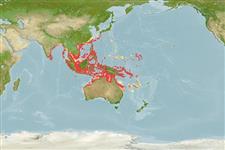>
Eupercaria/misc (Various families in series Eupercaria) >
Caesionidae (Fusiliers) > Caesioninae
Etymology: Caesio: Latin, caesius, bluish-grey, 1835; it is the same name given to the silvery metal (Cs) (Ref. 45335).
More on author: Bloch.
Environment: milieu / climate zone / depth range / distribution range
البيئة
بحري مرتبطة بالشعاب; غير مهاجرة; نطاق العمق 1 - 60 m (Ref. 86942). Tropical; 31°N - 28°S, 76°E - 172°E (Ref. 402)
Indo-West Pacific: Sri Lanka to Vanuatu; southern Japan to northern Australia.
الحجم / وزن / العمر
Maturity: Lm ? range ? - ? cm
Max length : 60.0 cm TL ذكر/ مختلط الجنس; (Ref. 402)
الأشواك الظهرية (المجموع) : 10; الأشعة الظهرية الناعمة (المجموع) : 14 - 16; شوكة شرجية: 3; أشعه شرجية لينه: 10 - 12. Deep-bodied (Ref. 48636). Scales center lighter than margins; lower 1/3 white, sometimes suffused by pink; prominent black markings on caudal fin absent. 4-5 scales on cheek; predorsal scales 20-26; scaled dorsal and anal fins. Upper peduncular scale rows 9-11; lower peduncular scale rows usually 12-14. Distinguished from C. teres in having a continuous supra-temporal band of scales across the dorsal midline. Basioccipital process for attachment of Baudelot's ligament absent. Post maxillary process single; posterior end of maxilla blunt. Color: Upper body if not yellow, grayish blue; lower sides and belly white or pinkish. Pectoral, pelvic and anal fins white to pink. Large yellow tail. Dorsal fin yellow posteriorly and grayish blue anteriorly. Length usually at 35 cm (Ref. 48636). Head length 2.8-3.6 in SL; body depth 3.0-4.2 in SL (Ref. 90102).
Often in silty areas with low visibility at 1-30 m depth (Ref. 90102). Inhabits coastal areas, usually over rocky and coral reefs. Forms schools in midwater and feeds on zooplankton. Oviparous, with numerous, small pelagic eggs (Ref. 402). Taken primarily by handline in Sri Lanka; caught mostly by fish traps in western Thailand and Malaysia; caught in trawls in the Gulf of Thailand; caught by a variety of methods including drive-in nets, fish traps and gill nets in Indonesia, the Philippines and Papua New Guinea. The most ancestral living caesionid species.
Life cycle and mating behavior
النضج | التكاثر | وضع البيض | بيض | الخصوبة | Larvae
Carpenter, K.E., 1987. Revision of the Indo-Pacific fish family Caesionidae (Lutjanoidea), with descriptions of five new species. Indo-Pac. Fish. (15):56 p. (Ref. 1723)
IUCN Red List Status (Ref. 130435: Version 2024-1)
استخدامات بشرية
مصائد: تجاري
أدوات
تقارير خاصة
Download XML
مصادر علي الأنترنت
Estimates based on models
Preferred temperature (Ref.
123201): 26.1 - 29.1, mean 28.3 °C (based on 1120 cells).
Phylogenetic diversity index (Ref.
82804): PD
50 = 0.5020 [Uniqueness, from 0.5 = low to 2.0 = high].
Bayesian length-weight: a=0.01622 (0.00944 - 0.02787), b=3.07 (2.92 - 3.22), in cm total length, based on LWR estimates for this species & (Sub)family-body (Ref.
93245).
مستوى غذائي (Ref.
69278): 3.4 ±0.45 se; based on food items.
المرونه (Ref.
120179): وسيط, الحد الزمني الأدني لتضاعف عدد أفراد المجتمع 1.4-4.4 سنة (Preliminary K or Fecundity.).
Fishing Vulnerability (Ref.
59153): Moderate vulnerability (44 of 100).
Nutrients (Ref.
124155): Calcium = 40 [26, 56] mg/100g; Iron = 0.627 [0.417, 0.912] mg/100g; Protein = 19.1 [18.1, 20.0] %; Omega3 = 0.13 [0.09, 0.18] g/100g; Selenium = 37 [24, 62] μg/100g; VitaminA = 85.9 [35.4, 208.2] μg/100g; Zinc = 0.991 [0.741, 1.300] mg/100g (wet weight);
